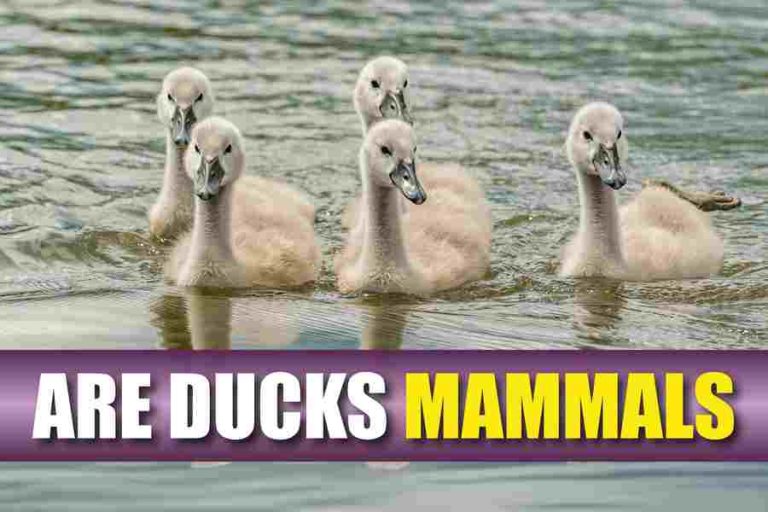Have you ever seen a duck and wondered whether it was a mammal? After all, it certainly looks like a warm-blooded creature with feathers, webbed feet, and a bill. But are ducks, in fact, mammals? The answer is more complex than you might think. In this article, we’ll explore the science behind our feathered friends and answer the question of whether ducks are indeed mammals. We’ll look at the anatomy, reproduction, and behavior of ducks and compare them to other mammals. We’ll also discuss how their classification has changed over time and how this has affected our understanding of these animals. So, if you’ve ever been curious about whether ducks are mammals or not, keep reading to find out!
Are Ducks Mammals?
The answer to this question is a little complicated, as ducks are technically classified as birds. However, many scientists believe that they are actually mammals, as they share many similarities with other mammalian creatures. For example, ducks have a layer of fat beneath their skin that helps them keep warm in cold weather, and they have a heart and liver that are similar to those of other mammals.
What Is A Mammal?
Mammals are a group of vertebrates that have certain characteristics in common. These include several bones in the skull, a spinal cord that ends in the abdomen, and milk production to feed their young. They also have hair (fur) which most species lose when they are born. Mammals are warm-blooded animals that feed their young with milk produced by special glands. Birds are also warm-blooded and feed their young with nutritious secretion from their glands. However, birds are not mammals. Birds and mammals evolved from reptiles.
Reproduction In Ducks
- Ducks are monogamous and mate for life.
- The male ducks build a nest out of sticks and leaves and co-parent with the female duck. It’s amazing to witness this level of commitment and loyalty between two birds.
- The female lays one or two eggs and incubates them for about 28 days.
- The chicks hatch, and the parents feed them for about three weeks.
- The young ducks leave the nest after about six weeks and fend for themselves.
- Ducks can live up to fifteen years in the wild.
- Ducks are hunted for their meat and eggs, but populations are slowly recovering.
- Ducks are classified as waterfowl, which means they are usually found in or near water.
- Ducks are very social animals and are considered to be one of the most intelligent birds.
- Ducks are fascinating creatures and deserve to be more widely known.
Comparing Ducks To Other Mammals
- Duck fat is similar to the layer of fat that humans and other mammals have beneath their skin to keep them warm in cold weather.
- Ducks have a heart and livers that are similar to those of other mammals.
- Ducks are warm-blooded animals that feed their young with milk produced by special glands.
- Birds are also warm-blooded and feed their young with nutritious secretion from their glands, but they are not mammals.
- Duck offspring can fly shortly after they hatch.
- Ducks are social animals and are typically very affectionate with their family.
- Ducks are adaptable and have a high tolerance for changes in their environment.
- Some people keep ducks as pets because they are so loving and social.
How Has The Classification Of Ducks Changed Over Time?
- In the past, duck classification was based on anatomical features. However, this has changed over time, and today, classification is based on behavioral traits.
- In the past, ducks were classified as birds because they shared many anatomical features with other birds. However, many scientists believe that they are mammals and share many similarities with other mammalian creatures.
- Ducks have a layer of fat beneath their skin that helps them keep warm in cold weather, and they have a heart and liver that are similar to those of other mammals.
- Ducks are warm-blooded animals that feed their young with milk produced by special glands.
- Birds are also warm-blooded and feed their young with nutritious secretion from their glands, but they are not mammals.
- Mammals evolved from a reptile-like ancestor during the Jurassic Period, while birds evolved during the Cretaceous Period.
- Mammals produce their young internally, and the young are nourished by milk from the mother’s mammary glands.
- Ducks are social animals and are very bonded to their family.
- Ducks are curious and playful and strong desire to be on the go.
- Ducks are adaptable and have a high tolerance for environmental changes, making them great pets for people who might not have the time and energy to spend on daily care and cleaning.
Conclusion
Ducks are warm-blooded, egg-laying vertebrates that are not mammals. Over time, the classification of ducks has evolved as scientists have learned more about the animals. Today, we know that ducks are waterfowl and belong to the order of Anseriformes. Indeed, ducks are fascinating animals that have been around for a long time. Their anatomy, reproduction, and behavior are all fascinating to explore. Furthermore, their classification has changed over time as scientists have learned more about these animals.
